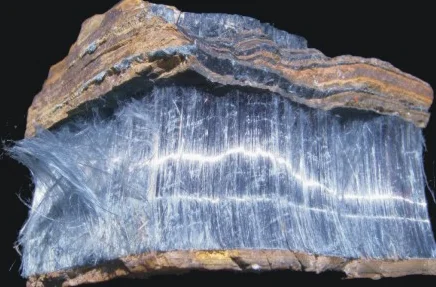What is Asbestos?
Asbestos is a naturally occurring mineral substance. Asbestos is in fact not a single type of mineral — rather, it refers to a group of silicate minerals that share the same fibrous nature. It was common to speak of “white asbestos” (chrysotile) which was commonly used, and the less often used “blue asbestos” (crocidolite) and “brown asbestos” (amosite). Asbestos can be pulled into a fluffy consistency. Asbestos fibers are soft and flexible yet resistant to heat, electricity and chemical corrosion. Pure asbestos is an effective insulator, and it can also be mixed into cloth, paper, cement, plastic and other materials to make them stronger. There are two general types of asbestos that are recognized by the US Environmental Protection Agency (EPA):
• Serpentine asbestos: Chrysotile
• Amphibole asbestos: Crocidolite, amosite, anthophyllite, tremolite, actinolite
Where is asbestos found?
For much of last century, the words “insulation” and “asbestos” were used almost interchangeably in the US. The first modern asbestos companies were formed in the late 1800s to serve the steam engines and rail industry. Asbestos insulation was available for every wall and pipe, from family homes to power plants.
Asbestos was easy to source from North American mines and cheap, so companies promoted as many uses for it as they could find. Asbestos became an essential component in a new generation of fire-resistant construction materials including cement sheets, roof sealants and adhesives for floor and ceiling tiles.
With World War II a massive demand for asbestos on U.S. naval ships and military bases developed. After the war, the asbestos industry produced asbestos insulation for homes and appliances as well as many components of automobiles.
The last American asbestos mine was closed in 2002. Consumption of asbestos in the U.S. peaked in the mid-1970’s at more than 800,000 metric tons — though global production of asbestos continues at 2 million tons per year, driven by demand in developing nations where asbestos insulation and cement are still commonly used.
Other consumer products were manufactured with asbestos-contaminated vermiculite or talc, exposing yet more Americans to the toxic mineral. The list of asbestos products goes on, ending only when the dangers of asbestos exposure were finally revealed to the American public in the 1970’s and 1980’s.
Currently, it is legal to include asbestos in almost all types of American products as long as the product does not contain more than 1 percent asbestos.
However, many old buildings and machines in the United States still contain high-percentage asbestos products that were manufactured before modern regulations came into effect. In addition, manufacturers in China and India routinely use asbestos in their factories.
The most common places where asbestos is found in homes is in:
• Vermiculite insulation
• Cement siding boards
• Pipe insulation
• 9 inch square floor tiles
• Textured paint
Should I be concerned?
Mold is not usually a problem indoors unless the spores land on a wet or damp surface and begin growing. As molds grow, they digest whatever they are growing on. Unchecked, mold growth can damage buildings and furnishings; molds can damage wood, damage drywall, and in extreme cases cause structural damage to buildings. The potential human health effects of mold are also a concern. It is important, therefore, to prevent mold from growing indoors.
Fungi in the indoor environment raises three major concerns:
1. The potential health effects of exposure to fungi and their byproducts;
2. The effects of fungal contamination on the structural integrity of a building; and,
3. The negative aesthetic effects fungi can produce both visually and on the human nose (smell).
Although the issue of whether exposure to indoor fungi causes adverse health effects is controversial, there is no
doubt that a seriously mold-contaminated building can suffer structural damage, and that a foul-smelling, fungus filled building is aesthetically unpleasing. Controversies about health effects aside, the latter two reasons are sufficient to merit a Complete Mold Inspection and remediation when an environment is found to have fungal
contamination. People who have concerns about structural damage, the aesthetic effects, or possible effects on health of indoor fungi should seek the services of a Certified Mold Inspector. People who have concerns about possible effects they may be experiencing related to mold should seek the advice of a healthcare professional.
What are the health concerns with asbestos?
Asbestos fibers most often accumulate in lung tissue and in the membrane lining the lungs called the pleura. Benign asbestos-related diseases include asbestosis, pleuritis and chronic obstructive pulmonary disease (COPD), which make it difficult for patients to breathe.
Asbestos also causes malignant diseases such as lung cancer, pleural mesothelioma and peritoneal mesothelioma, and it is the No. 1 cause of occupational cancer in the world.
What can be done about asbestos?
Many American buildings constructed before 1980 contain asbestos, and asbestos-containing materials come in many forms. Unless a product is clearly marked, you cannot determine whether it contains asbestos just by looking at it.
Sometimes it is vital to remove an asbestos-containing material, and sometimes it is safest to leave the material undisturbed. The evaluation and removal of asbestos should be left to certified asbestos abatement professionals.
Can suspicious materials be tested?
Yes, any material in a home that is a suspected asbestos containing material (“ACM”) can be tested. The testing required collecting samples of the material. The type of material and location of the material will determine the amount needed and the number of samples needed.
It is important to understand that collecting samples is generally a process that causes damage to the home. Floor samples need to be removed from the floor; (small) areas of the siding are removed, and areas of insulation are removed. When the sampling is done, every best effort is made to minimize the impact to the home and leave as little damage as possible. Testing procedures are dictated by the Maine Department of Environmental Protections Rule 425.
Following the collection of the samples, the samples are sent to a Maine State approved laboratory for analysis.





